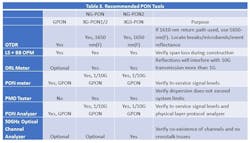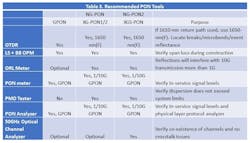As cable operators deploy fiber deeper into their networks and use it to serve a growing number of applications, fiber-optic testing obviously becomes more important. Unfortunately, it also becomes more complex. Fiber types might change, connectors might change and the nature of the optical transmission might change (both in the type of transmission as well as in the number and location of wavelengths). Meanwhile, the crews assigned to install and troubleshoot new fiber-optic connections might not change – they may be the same technicians who have been working with coax for most of their careers.
Therefore, cable deployment crews need test equipment that is easy to operate even if the user has had little exposure to optical networking. These test sets also should be useful in a wide variety of scenarios. Optical test instruments have evolved rapidly over the past few years in response to these requirements. Which is a good thing, as future optical networks promise even thornier test problems.
Keeping pace with changing circumstances
Automation has proved the main weapon for test instrument vendors in the battle against growing optical evaluation complexity. From ribbon fiber inspection to PON operation certification, such automation enables technicians to set up and execute tests rapidly and accurately, even with what might be regarded as a minimum of training. That automation can extend to documentation of the procedures and results as well.
Meanwhile, to make their instruments applicable to a wider variety of applications, test equipment vendors have embraced modular designs that support a wider range of interfaces. The necessary software to perform the tests assigned for the day can be downloaded into such instruments as needed, often from a remote source in a cloud-based manner. Again, the technician can send the results of the tests back to a central facility for later evaluation or trend analysis via the cloud as well. Portability goes hand-in-hand with such modularity.
Meanwhile, optical communications equipment vendors are helping to make things easier for cable operators by building in lower-level test capabilities into their systems. PON optical line terminals and other optical transport hardware may have optical time-domain reflectometer (OTDR) capabilities built in that can provide hints about fault locations to technicians before they enter their trucks for further investigation.
Things to come
The evolution toward more automated, cloud-friendly, multi-use instruments comes just in time for significant changes in the optical communications technology cable operators will have at their disposal. While certain test will remain essential – including fiber/connector inspection, transceiver certification, insertion loss and optical return loss evaluation, and OTDR measurements – how these tests are conducted and what they’re seeking to measure likely will change.
Next-generation PON technology is a good place to start. Whether an operator has deployed EPON or GPON, new technology that will support at least 10 Gbps per wavelength (and certainly more in upcoming next-generation EPON standards) and potentially over multiple wavelengths is on its way. As an example of the effects on test procedures, the table below lists the test capabilities one test instrument vendor suggests operators have in stock as they roll out XGS-PON or NG-PON2, particularly if they plan to offer services via these technologies alongside existing GPON-based services.
And that doesn’t take into account any testing that might be required on the tunable optical network terminal (ONT) transceivers NG-PON2 will demand. Next-gen EPON, thankfully, won’t require such tunability. But we’re likely looking at higher transmission rates than the 10 Gbps of NG-PON2 wavelengths.
Meanwhile, as network managers consider a move toward Distributed Access Architectures, optical test requirements will evolve as well. In an SCTE LiveLearning Webinars™ for Professionals webcast on April 26, Stephen Colangelo of VIAVI Solutions noted that test requirements likely will include Ethernet testing on top of such traditional measurements as insertion loss, return loss, and connector inspection. Dispersion testing also may be required.
But the big unknown as far as optical testing is concerned is where operators will use coherent detection. The technology has become essential for long-haul and metro networks as transmission rates move to 100 Gbps and greater. The question is how much of a role coherent transmission will play in other parts of the network. CableLabs is evaluating coherent for use in the access network as a means to enable older fibers designed for support of no more than a few gigabits per second (if that) to be used to support Distributed Access Architectures and Full Duplex DOCSIS, where transmission rates can reach 10 Gbps (or perhaps more if the link needs to support multiple service types; see "A Light Lunch: CableLabs Eyes Coherent Optics" and "Full duplex coming soon to a fiber near you").
One of the fiber effects relevant to coherent detection is polarization mode dispersion (PMD), something operators didn’t have to worry about much with standard non-return-to-zero, on/off keying modulation (coherent encodes signal information into phase as well as amplitude, so polarization gets involved). A significant amount of digital signal processing (DSP) is applied to coherent transmissions to mitigate the effects of PMD. Systems vendors will tell you that such DSP does such a good job that PMD and chromatic dispersion, and therefore PMD and chromatic dispersion testing, is irrelevant; test instrument vendors disagree. The test equipment suppliers’ case is particularly strong where conventional transmissions will share the same fiber as coherent transmissions. One would think as well that the older the fiber in question, the more necessary both PMD and chromatic dispersion measurements would be when looking at transmitting multiple gigabits per second.
The rapidly evolving optical network environment has put significant pressure on deployment and troubleshooting technicians. Test instrument vendors have attempted to ease the technician’s burden – but there’s likely more work to be done as new optical technologies reach the field.
Stephen Hardy is editorial director of Broadband Technology Report.
Learn more about optical testing
You can now view on-demand the April 2018 SCTE∙ISBE LiveLearning Webinars™ for Professionals webcast, produced by BTR, "Testing and Measuring Optics." The growing interest in fiber deep deployments has put new emphasis on the ability of technicians to quickly and accurately measure fiber-optic networks. This webinar highlights what technicians need to know as well as how to ensure accurate, efficient optical network measurements. Register for the webinar and view it now!






